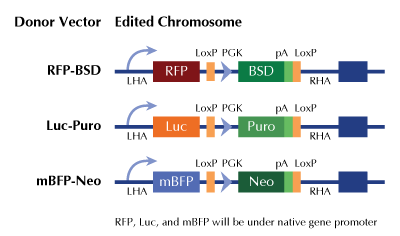TLR2 Human Gene Knockout Kit (CRISPR)
CAT#: KN207597RB
TLR2 - human gene knockout kit via CRISPR, HDR mediated
Functional Cassette: GFP-puro Luciferase-Puro mBFP-Neo
HDR-mediated knockout kit validation
USD 1,657.00
4 Weeks*
Specifications
| Product Data | |
| Format | 2 gRNA vectors, 1 RFP-BSD donor, 1 scramble control |
| Donor DNA | RFP-BSD |
| Symbol | TLR2 |
| Locus ID | 7097 |
| Components |
KN207597G1, TLR2 gRNA vector 1 in pCas-Guide CRISPR vector KN207597G2, TLR2 gRNA vector 2 in pCas-Guide CRISPR vector KN207597RBD, donor DNA containing left and right homologous arms and RFP-BSD functional cassette. GE100003, scramble sequence in pCas-Guide vector |
| Disclaimer | These products are manufactured and supplied by OriGene under license from ERS. The kit is designed based on the best knowledge of CRISPR technology. The system has been functionally validated for knocking-in the cassette downstream the native promoter. The efficiency of the knock-out varies due to the nature of the biology and the complexity of the experimental process. |
| Reference Data | |
| RefSeq | NM_001318787, NM_001318789, NM_001318790, NM_001318791, NM_001318793, NM_001318795, NM_001318796, NM_003264 |
| UniProt ID | O60603 |
| Synonyms | CD282; TIL4 |
| Summary | The protein encoded by this gene is a member of the Toll-like receptor (TLR) family which plays a fundamental role in pathogen recognition and activation of innate immunity. TLRs are highly conserved from Drosophila to humans and share structural and functional similarities. This protein is a cell-surface protein that can form heterodimers with other TLR family members to recognize conserved molecules derived from microorganisms known as pathogen-associated molecular patterns (PAMPs). Activation of TLRs by PAMPs leads to an up-regulation of signaling pathways to modulate the host's inflammatory response. This gene is also thought to promote apoptosis in response to bacterial lipoproteins. This gene has been implicated in the pathogenesis of several autoimmune diseases. Alternative splicing results in multiple transcript variants. [provided by RefSeq, Jan 2016] |
Documents
| Product Manuals |
| FAQs |
| SDS |
Resources
Other Versions
| SKU | Description | Size | Price |
|---|---|---|---|
| KN207597 | TLR2 - human gene knockout kit via CRISPR, HDR mediated |
USD 1,657.00 |
|
| KN207597BN | TLR2 - human gene knockout kit via CRISPR, HDR mediated |
USD 1,657.00 |
|
| KN207597LP | TLR2 - human gene knockout kit via CRISPR, HDR mediated |
USD 1,657.00 |
|
| KN407597 | TLR2 - KN2.0, Human gene knockout kit via CRISPR, non-homology mediated. |
USD 1,657.00 |
|
| GA104898 | TLR2 CRISPRa kit - CRISPR gene activation of human toll like receptor 2 |
USD 1,657.00 |
{0} Product Review(s)
Be the first one to submit a review






























































































































































































































































 Germany
Germany
 Japan
Japan
 United Kingdom
United Kingdom
 China
China
